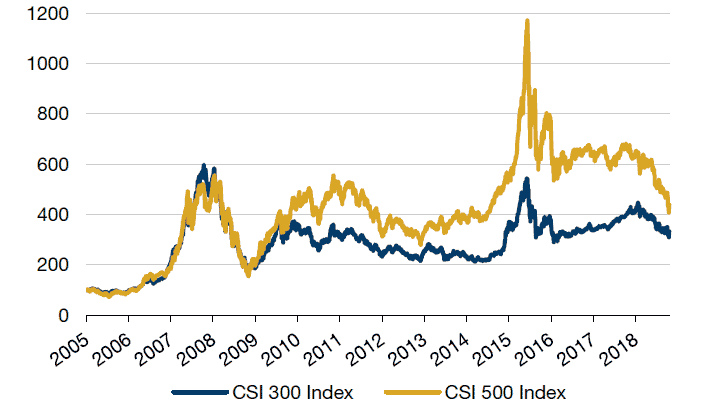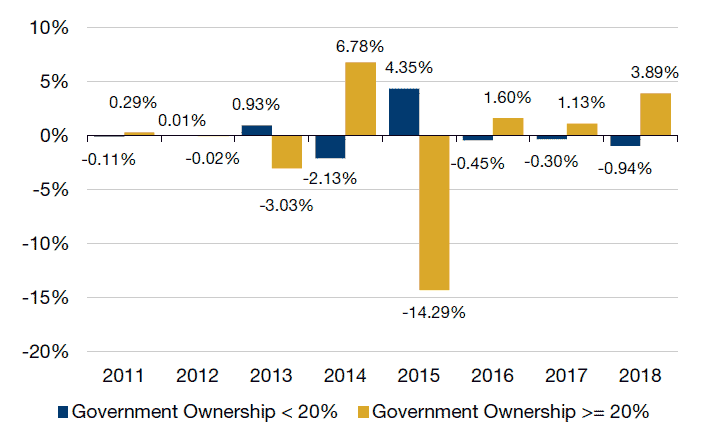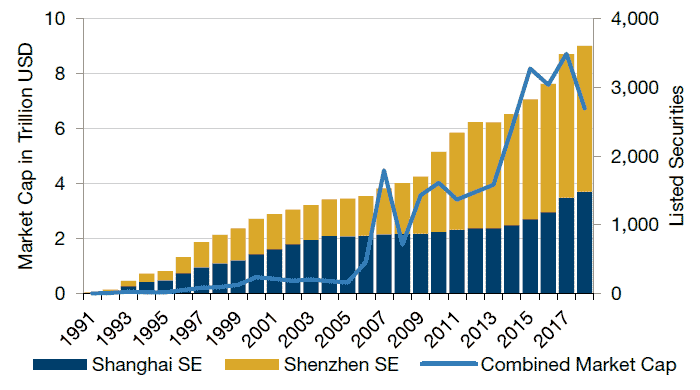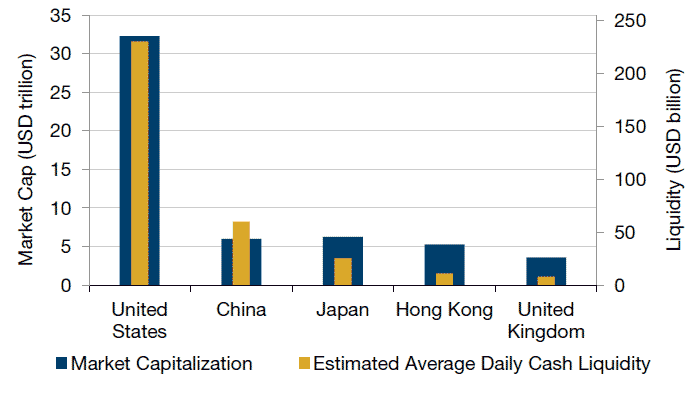Low historical correlation to both DM and EM, along with a high retail investor base, may provide an opportunity in China’s state-owned enterprises.
Low historical correlation to both DM and EM, along with a high retail investor base, may provide an opportunity in China’s state-owned enterprises.
January 2019
The Value in China's SOEs
Investing in China has often been met with a bit of hesitation due to concerns about the country’s state-owned enterprises (‘SOEs’). China’s SOEs account for near 40% of its stock market and more than a third of its public investment.1
There are two main worries about investing in China that are specific to SOEs. The first is that minority shareholder interests may not necessarily be the top priority for SOEs. Indeed, taking size as a proxy for SOEs, the CSI 500 Index has outperformed the CSI 300 Index since 2005, but has given up some of those gains starting in 2017. Secondly, investors worry about the debt on the SOEs’ balance sheet given that the SOEs can tap cheap financing from the state-owned banks.
Figure 1. Small Versus Large in China

Source: Bloomberg; Between January 4, 2005 and October 22, 2018. Normalized to100 as of January 4, 2005.
However, major strides of improvement have been made in both areas: total operating profits for the top 60 listed SOEs (excluding banks) have risen by 17% since 2016, according to the Economist, which cites Bloomberg data.2 Regarding the debt levels, in January, analysts from Moody’s forecast debt/EBITDA ratios at the SOEs to decline to “5.4x in 2018 from 5.5x in 2016 and 5.7x in 2015”.3
Indeed, SOEs at the right price can pay off. After a big sell-off in 2015, China’s SOEs recovered in the subsequent three years due to their potential valuation proposition (Figure 2). More recently in 2018, and specifically during the third quarter, companies with higher government ownership outperformed the broader China A-Shares market on a sector and size neutral basis. We believe this is because SOEs are less affected by the ongoing deleveraging campaign in China and less sensitive to credit risk, thanks to higher quality bonds, lower borrowing costs and less reliance on shadow banking.
Figure 2. China’s SOEs Outperformed in 2016, 2017 and So Far in 2018.

Source: Bloomberg, Man Numeric; 2018 calculations are as of September 30.
Additionally, SOEs – because they are large-cap and cheap on average – tend to be more ‘value’ than ‘growth’. This hasn’t necessarily worked in SOEs’ favour in the past – this past third quarter notwithstanding. However, we believe that as the Chinese growth stocks, and specifically those in the technology sector, lose their sheen, value stocks could take their place. Our view is that just because a company is an SOE, doesn’t mean that there isn’t value.
The Value in China's A-shares
In fact, the China A-Shares market generally represents a potentially compelling investment opportunity for foreign investors looking to diversify their portfolios, from both an alpha and a beta perspective.
Crucially, financial investors have had very limited opportunity in the past to participate in this growth owing to various capital limits imposed by the government. However, this has begun to change in recent years, with the launch of the Shanghai-Hong Kong Stock Connect program in late 2014. This allowed international investors to purchase A-Shares traded on the Shanghai Stock Exchange via Hong Kong-based brokers, and a similar program for the Shenzhen Stock Exchange in December 2016.
The opening up of the stock market would be of limited use to large international investors if it did not offer liquidity in line with its economic stature. On this front, the progress of the Chinese market has been both dramatic and impressive – in just 25 years of existence it has grown to become one of the world’s largest and most liquid equity markets in the world (Figure 3). From our own perspective, the universe of Chinese stocks considered to be ‘investible’ has doubled in the past seven years, with the median stock within this group having a market cap of USD800 million and average daily liquidity of USD5 million.4
Figure 3. China’s Market Capitalisation and Liquidity


Source: Man Numeric, SSE, SZSE, Bloomberg; As of September 30, 2018.
The A-Shares market also has a number of structural attractions for professional active investors in particular.
First, while less specifically an argument for an active approach, the China A-shares market can help provide diversification from developed and emerging markets. Albeit more limited since the launch of the Stock Connect program, the potential diversification benefit is also greater than from the China H-Share market, due to its more limited access for foreign investors. The average correlation of the MSCI China A-Share Index with the MSCI Emerging Markets Index and the MSCI World Index since 2005 has stayed below 0.3 and 0.2, respectively. For investors who already have exposure to China through the H-Share market, the A-Share market may therefore still represent a real diversification opportunity since the average correlation between these two markets has historically been 0.5.
Figure 4. Average Correlation of Weekly USD Returns
| MSCI China A-share | MSCI Emerging Markets | MSCI World | |
|---|---|---|---|
| MSCI China A-share | 0.51 | 0.30 | 0.18 |
| MSCI China H-share | 0.82 | 0.63 | |
| MSCI Emerging Markets | 0.84 |
Source: Man Numeric, Bloomberg; Between January 2005 and September 2018.
Secondly, there is the notable increase in domestic retail investor interest to consider: individual investors make up 80% of the trading volume in China’s stock market.5 We believe that this is an opportunity for skilled active managers seeking to generate alpha.
Conclusion
A well-known feature of the Chinese equity market is the high incidence of government ownership. Since such companies may not only be run on the basis of profit or shareholder interest maximization, their performance may lag private sector counterparts, with their stock trading at a discount. Active investors skilled in recognizing and modelling investor biases could therefore have a potential edge in this space. Additionally, as China continues opening up to foreign capital, it is increasingly clear to us that foreign investors can no longer afford to ignore it. Low historical correlation to both developed markets and other emerging markets suggests a potential diversification benefit from investing in China A-Shares, while the high retail investor base provides an alpha-generating opportunity for the savvy stock-picker.
1. http://www.atimes.com/reforming-chinas-state-owned-enterprises/
2. https://www.economist.com/business/2018/03/01/are-chinas-state-giants-r…
3. https://www.ft.com/content/b0ed4d21-bc9a-38dd-9af9-bc3aac6e7a13
4. Please note: These figures relate to Man Numeric’s self-defined universe of investible China A-Shares.
5. https://www.bloomberg.com/news/articles/2017-09-27/in-china-it-s-global…
You are now exiting our website
Please be aware that you are now exiting the Man Institute | Man Group website. Links to our social media pages are provided only as a reference and courtesy to our users. Man Institute | Man Group has no control over such pages, does not recommend or endorse any opinions or non-Man Institute | Man Group related information or content of such sites and makes no warranties as to their content. Man Institute | Man Group assumes no liability for non Man Institute | Man Group related information contained in social media pages. Please note that the social media sites may have different terms of use, privacy and/or security policy from Man Institute | Man Group.